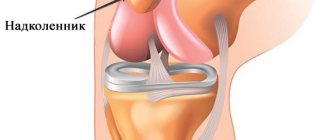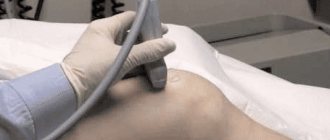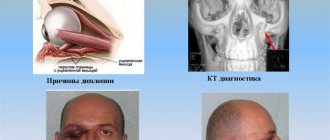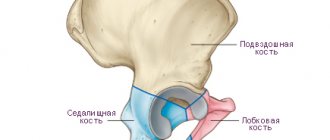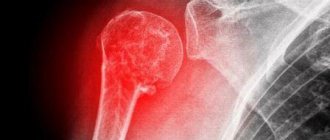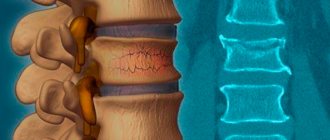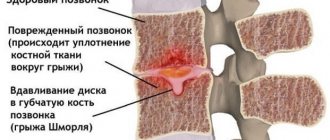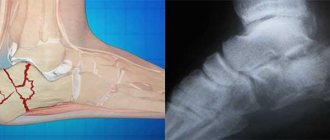A fracture is a painful condition in which the integrity of the bone occurs as a result of injury under the influence of a damaging factor that exceeds the strength of the bone tissue. Fractures are of two types: open and closed, with and without displacement of bone fragments. After an injury, the bones heal until a callus is formed. This process is called fracture consolidation . Accordingly, consolidating is a healing fracture. There are fast and slow consolidations. Rapid consolidation is the complete fusion of bones, in which callus is formed and blood circulation is restored. Delayed consolidation is a failure of bone healing with slow callus formation. As a result, the fracture may heal incorrectly and cause a lot of inconvenience to the patient.
What is a fracture?
A surgeon and traumatologist are the specialists to whom people with a bone fracture turn.
A fracture is a partial or complete disruption of the integrity of bone tissue that occurs under a load several times greater than the strength of the damaged area of the skeleton. This pathological condition can occur not only due to injury, but also as a result of various diseases that are accompanied by significant changes in the strength properties of bones.
Having contacted a free or paid emergency room, a patient with an injury immediately receives treatment. It depends on the severity of the fracture, which, in turn, is determined by the size of the broken bones, as well as their number.
It should be especially noted that multiple fractures of tubular bones (large) very often lead to traumatic shock and the development of severe blood loss. However, by contacting a free or paid emergency room in time, such pathologies can be avoided. By the way, patients recover very slowly after receiving such injuries. Their recovery period may take several months.
Consolidated fracture - what is it?
The term "consolidation" is of Latin origin. It consists of two syllables, which are translated as “together” and “strengthen.” In other words, consolidation means: to unite, strengthen, integrate or unite something.
So what is this - a consolidated fracture? Experts say that this is a medical term that refers to a fracture that has already healed with the formation of a callus.
Ideal and complete fusion of the injured skeleton occurs in the following cases:
- with good fixation of broken bones;
- with complete and ideal comparison of bone fragments;
- when restoring blood circulation in the area of bone damage;
- when restoring or maintaining innervation in the area of bone tissue damage.
Secondary fusion
Secondary healing of fractures with the formation of cartilaginous callus occurs when:
- incomplete comparison of parts of bone fragments;
- poor fixation of the fracture;
- relative mobility of bone fragments;
- untimely immobilization;
- impaired blood circulation, as well as innervation in the area of bone fracture.
Why doesn't the fracture heal?
A surgeon, a traumatologist - these are the specialists who can answer the question of why in some cases a bone fracture does not heal. According to them, this phenomenon has several reasons. Let's imagine them right now:
- violation of immobilization of the (damaged) bone, as well as displacement of its elements relative to each other;
- incomplete or incorrect comparison of bone fragments;
- disruption of innervation in the area of the fracture and local circulation.
A traumatologist visits your home only in extremely severe cases. It is very important that the specialist is competent. Indeed, in case of serious fractures, it is necessary to combine the damaged bone tissues so that their complete consolidation occurs. However, it should be noted that such fusion depends not only on the qualifications of the doctor. After all, all layers of bone tissue (for example, endosteum, periosteum and Haversian canals) must be included in the regeneration process.
It should also be said that, together with the natural physiological processes of restoring the integrity of the skeleton, the resorption of post-traumatic hematoma also occurs. By the way, callus during regeneration has the appearance of a small spindle-shaped thickening.
Surgical techniques
Let's say a specialist has diagnosed a lumbar, cervical or thoracic spinal fracture, rehabilitation is described at the end, saying that there will be a surgical treatment. What surgical techniques are used to correct the shape, height and anatomical integrity of the vertebra? Today, in orthopedics and traumatology, unique gentle methods are used that involve closed surgery, that is, during a particular procedure, the surgeon does not make large incisions and does not expose the damaged element at all. Such loyal stabilizing procedures include vertebroplasty or kyphoplasty.
- Vertebroplasty involves injecting bone cement into the vertebral body through a syringe. First, local anesthesia is administered, and after the analgesic effect occurs, a special guide needle is inserted into the cavity of the defective object. A syringe filled with a semi-liquid mixture based on acrylates is connected to the conductor wire. Next, the specialist squeezes a unique solution into the vertebra, where it fills all the voids and cracks, replenishing the height of the body. After 10 minutes, the cementoplastic mass “sets”, turning into a hard material similar to bone, only much stronger. The advantage of the procedure is that the element that was corrected with cement also acquires “immunity” to a similar type of destruction. After such a microinvasive session, there is no need to wait painfully for the spinal fracture to heal; treatment and rehabilitation are carried out in a short time.
- Kyphoplasty is a procedure similar to the previous tactics, but its principle is based on placing a special balloon through a probe inside the vertebra, after which it is inflated. Inflating the balloon helps to very well align the geometry and height of the distorted body. Next, cement is injected into the intravertebral structures in the same way as in vertebroplasty. Thus, this session copes equally successfully with the reconstruction of the destroyed area. Plus, it not only raises a certain link to its normal level and restores its strength resource, but also prevents its destruction in the future, and also corrects abnormal curvatures of the column.
Both techniques are especially widely used when a compression fracture of the thoracic spine is diagnosed of osteoporotic etiology; rehabilitation, by the way, is very easy to tolerate and does not require lying in bed for months. It is enough to lie down after the manipulations for several hours, a maximum of a day, and calmly go home on your own feet. It is worth noting that these technologies are also highly effective in restoring broken vertebrae located at the level from the coccyx to the ribs, as well as in the neck area.
The two technologies are of particular value for older people, since thanks to the use of a high-tech cement composition, signs of osteoporosis in the corrected part are completely eliminated. Moreover, they involve a very gentle intervention with minimal risks of side effects, and also do not require the use of aggressive types of anesthesia.
Periods of formation and layers of callus
Consolidated fracture of ribs and other parts of the skeleton is a fairly common occurrence. During the process of bone repair, callus is formed.
This regeneration takes place in three periods:
- development of inflammation (aseptic) at the fracture site;
- process of bone formation;
- reconstruction of bone callus.
Thus, at the site of injury in a person, intensive proliferation of cells of the Haversian canals and endosteum, as well as connective tissue and periosteum, occurs. This process leads to the formation of a callus at the fracture site. It consists of four layers:
- paraosseous;
- intermediary;
- periosteal;
- endosteal.
5-6 days after the actual injury, the defect between the bone fragments begins to be filled with fibroblasts, osteoblast cells and small vessels, which form osteoid tissue.
It should also be noted that there are 3 stages of callus formation. These include:
Diagnostic control
Since each person's recovery process is different, it is necessary to constantly monitor it to avoid the development of unforeseen complications.
You should monitor the fusion of bones in this way:
- Visit your doctor regularly to examine the fracture site. A specialist will be able to identify suspicious deviations or confirm that the regeneration process is proceeding without failures.
- An x-ray will be required, since only a photo can be used to see what stage the process is at. X-rays will also help determine whether the bones are fused in the correct position. Pictures are taken in several projections, for example, the fusion of the ribs on the right needs to be illuminated from the side and front/back.
It is recommended to attend physiotherapeutic procedures and exercise therapy if you want to strengthen the osteoid callus and speed up the process of building a normal bone structure.
How long does it take for callus to form?
The formation of callus is a rather lengthy process. The terms of its formation are as follows:
- Primary (lasts 4-5 weeks).
- Secondary (after 5-6 weeks).
It should also be noted that the callus at the fracture site undergoes restructuring over several years. This occurs due to the fact that osteoblasts promote the resorption of the ends of bone fragments, fragments and splinters, and also eliminate the excessive formation of callus.
Why is consolidation slowing down?
Not always and not in all people do bone fractures heal quickly and without any consequences. In some cases, consolidation of the injured area slows down significantly. What is the reason for this phenomenon?
Common causes of delayed bone healing include the following:
- diabetes mellitus, thin bones, dysfunction of the parathyroid glands;
- old age, female gender, ovarian cyst, unhealthy diet;
- exhaustion, multiple pregnancy, stress;
- short stature, taking certain medications, dysmenorrhea;
- oncology, smoking, removed ovaries, internal organ transplantation, etc.
As for local reasons, they include:
- infection in the wound;
- circulatory disorders;
- severe crushing of soft tissues due to injury;
- multiple fractures;
- foreign objects entering the wound;
- interposition of fabrics, etc.
Folk remedies
To speed up fracture recovery, it is necessary to combine traditional methods with medications and non-drug methods. Their use is possible only after consultation with a specialist and determination of the safest method of traditional therapy. To achieve a therapeutic effect, decoctions, infusions are used, and compresses and lotions are applied. The most effective folk methods include:
- Taking a decoction of meadow cornflower. To prepare the solution, you need to boil 50 grams of dry herb for two hours, after which the mixture is cooled and filtered. They should be taken twice a day with a single dosage volume of 200 ml.
- Mumiyo. Shilajit tablets are consumed within 10 days before meals.
- Comfrey compress. First you need to boil 50 grams of the herb and then mix it until the contents are homogeneous. The paste is applied to the area of injury before going to bed and after applying a bandage, it is kept until the morning. The procedures are performed throughout the entire length while bone consolidation occurs.
- A mixture of juniper and oil. Juniper branches along with needles are mixed with butter. The mixture is left in the oven for 3-4 hours, then the ingredients are thoroughly crushed to form an ointment. It is used for massage to achieve anti-inflammatory and warming effects.
Consequences of improper treatment
A consolidated fracture is the best outcome for a person's injury. However, it should be noted that if not treated properly, consolidation may not occur or may be delayed.
Experts say that the following conditions are signs of slow fusion of bone tissue:
- mobility (pathological) of bones at the fracture site;
- severe pain in the area of injury;
- a gap between bone fragments, noticeable during X-ray examination.
It should also be noted that in childhood the process of restoration and regeneration of damaged bone tissue occurs faster and easier than in elderly and adult people. Very often, improper fusion of the skeleton leads to the formation of a false joint. Such joints can give rise to a number of serious health problems, as well as cause aesthetic discomfort.
Delayed fracture consolidation is the process of slowly healing damaged bone until a callus forms. This is a pathological violation of natural regeneration, which can be provoked by spill factors. What this means can only be understood by studying how the normal process of consolidation should take place.
